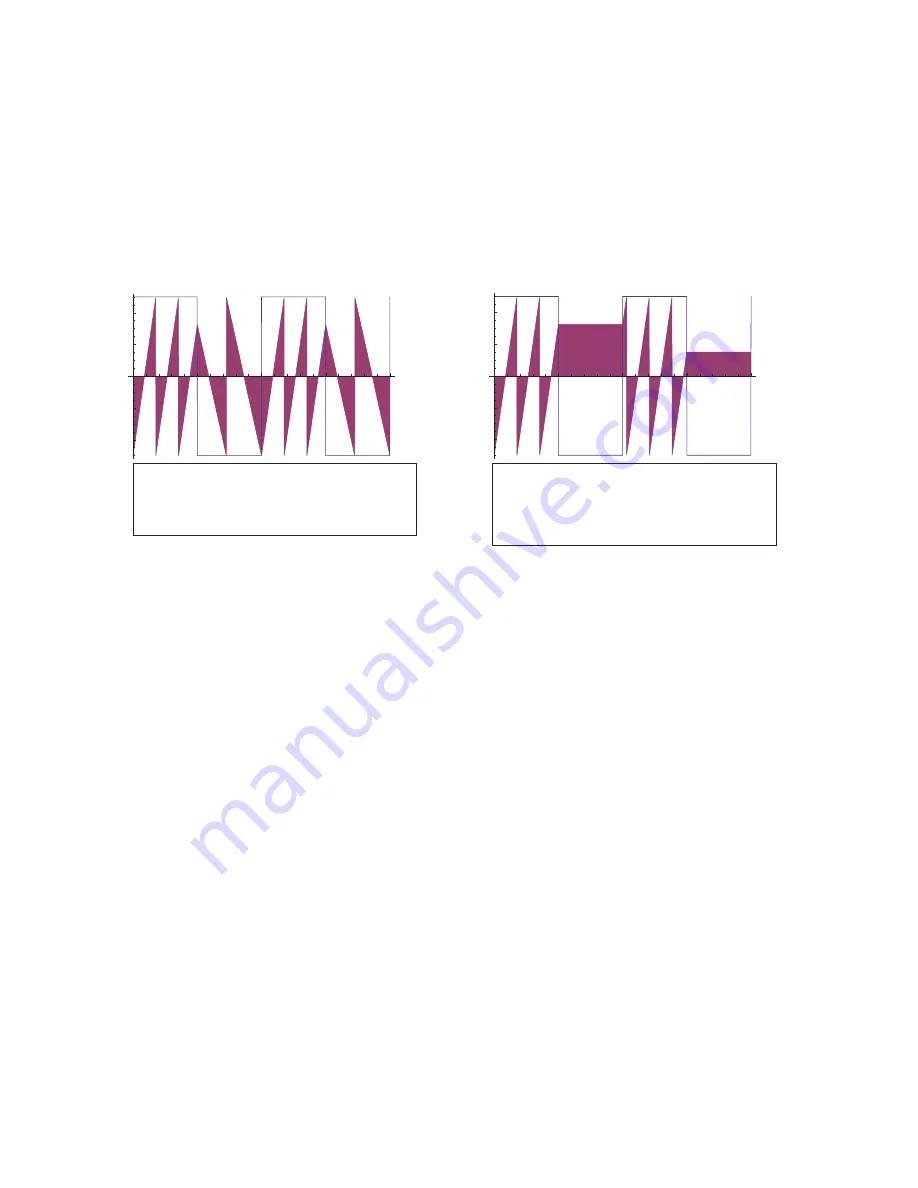
9
Thru-zero oscillator FM
The term ‘thru-zero FM’ refers to the ability to modulate the frequency of an oscillator beyond zero into negative frequency
values. Negative frequencies are vitally important for a stable pitch response with any possible amount of modulation,
and is a prominent characteristic of the Yamaha DX-series’ implementation of FM. Cypher’s implementation gives you
digital FM-style sounds rendered by a realistic analogue circuit model, with the convenience and polyphony of a software
instrument.
Thru-zero FM is not usually possible with analogue oscillators – instead of the frequency travelling beyond zero when
modulated, it simply stops at zero until the modulation causes it to rise into positive values again. The result is that, at
harmonic ratios, the overall pitch that is heard is irregular at lower frequencies. Thru-zero FM allows for the timbre to
remain harmonic at all frequencies even with very large modulation.
The following waveform plots show thru-zero and normal analog FM using a square wave as the modulator, and a
sawtooth wave as the signal being modulated. While the square wave is high, the pitch of the saw is increased, and when
the square wave is low the pitch is decreased.
0.5
1.0
1.5
2.0
Time mS
0.4
0.2
0.2
0.4
Voltage V
0.5
1.0
1.5
2.0
Time mS
0.4
0.2
0.2
0.4
Voltage V
Thru-zero FM:
The decrease in pitch results in a negative
frequency, and the saw-up waveform becomes a saw-
down waveform. A triangle waveform corner is created
at the point of transition.
Normal analogue FM:
The osc is unable to produce a negative frequency when
the pitch decreases. It becomes clamped at zero and
stays constant until the modulator increases the pitch.
The result is that the resulting pitch is not the same as
the original saw wave.
There are currently some thru-zero analogue oscillators available for modular systems, such as the Cyndustries
Zeroscillator. However, these tend to be rather expensive (especially if you need a polyphonic system) and there are still
inherent problems such as the inability to achieve exact tuning ratios.
Thru-zero FM is very easy to implement on digital synths that use wavetable-lookup techniques, such as the Yamaha DX
series. Cypher’s oscillator FM is capable of thru-zero FM using true virtual oscillators generated in real time, without using
wavetable-lookup techniques (which cannot offer the same sound quality as a modelled analogue-style oscillator).
Filter FM
Another classic use of analogue FM is to modulate the cutoff frequency of a filter at audio-rates such as that of an
oscillator. Cypher allows you to modulate both of its two filters at audio-rate, using Osc3 as the modulator.
Again, this technique is used in order to obtain a change in timbre by modulating the filter cutoff at very fast speeds.
Turning up the FM3 control on the filter reduces the action of the filter while introducing additional harmonics, resulting in
a buzzy and aggressive sound.
The effect tends to be more pronounced at higher resonance settings, especially as the filter begins to self-oscillate – in
such situations, filter FM is effectively like performing FM on a sine wave.
As with oscillator FM, the frequency (pitch) of the modulating oscillator is an important factor in determining the character
of the resulting signal.
Thru-zero FM on a filter is inherently impossible in both analogue and digital domains. Therefore, if the amount of
frequency modulation away from the initial filter cutoff frequency would take the frequency value beyond zero into negative
values, the frequency stays at 0 Hz until the modulation again raises it higher again. This means that in such situations,
the resulting timbre changes with the pitch of the signal going through the filter, meaning that Cypher’s filter FM behaves
exactly like that of a real analogue filter.
Envelopes and LFOs
FM depths become much more interesting when modulated by envelopes or LFOs. You must use the TransMod system in
order to achieve this – select an Env or LFO as the source of a TransMod slot and set a modulation depth on the
FM from
control on Osc2 or the filter section.
Programming hints
Extreme amounts of audio-rate modulation can be great when you want wild and experimental sounds, but for most
useful, ‘musical’ sounds, try to use smaller amounts. The same is true of modulating FM depth controls with the TransMod
system – for useful rather than crazy sounds, try to find sweet spots within small depth ranges.
Try also looking at the factory Cypher presets for ideas and inspiration. Figuring out how sounds have been created using
synthesis parameters is more immediate and practical than studying text-books about mathematical FM theory.
Make sure to look at all used TransMod slots to see exactly what is going on in the preset!
Содержание DCAM SYNTH SQUAD
Страница 1: ......
Страница 2: ......
Страница 26: ...26 Shaper Filter Amp sections...
Страница 109: ......
Страница 110: ......






























